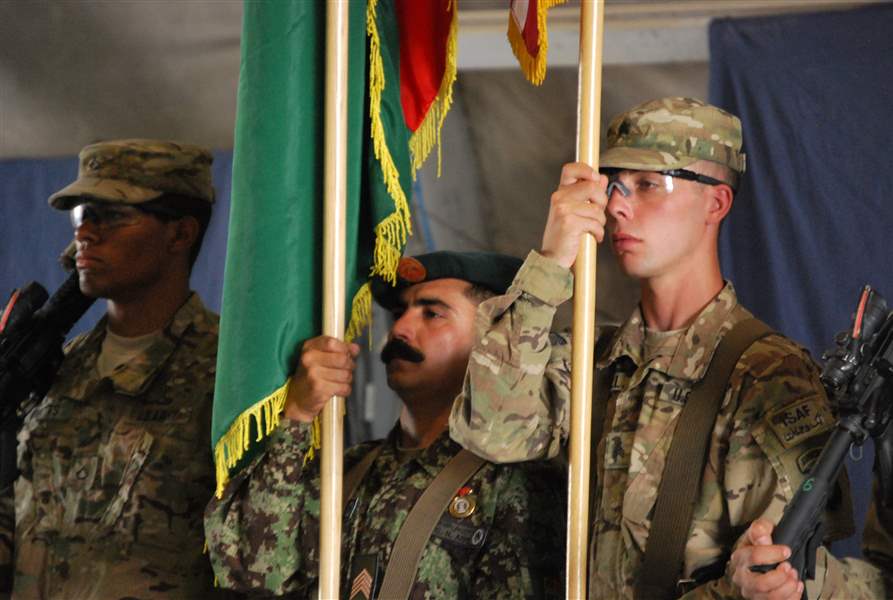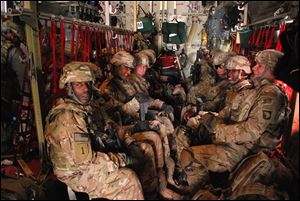
Once in the lead, U.S. advisers find frustrations, success in counseling Afghan military
6/9/2013
ASSOCIATED PRESS

Heading toward the troop draw down in 2014, American combat brigades are being replaced by teams of advisers to assist the Afghan security forces.
FORWARD OPERATING BASE FINLEY-SHIELDS, Afghanistan — In previous years, the U.S. Army would have helped the Afghan National Army if their troops had run out of fuel or money or run into some other logistical problem, but with the U.S. getting ready for a significant withdrawal, the Americans are teaching the Afghans to rely on themselves.
The U.S. military's new role of trying to train and mentor a young Afghan army comes after nearly 12 years of war. U.S. troops have borne most of the fighting over the past decade, but now the Afghan military is taking the brunt of the fighting against a resilient insurgency while the U.S. takes on more of an advisory role.
It is a daunting task for both countries.
U.S. Army Lt. Col. Matthew Stader usually commands a field artillery battalion, but this year he's leading a team of military advisers in eastern Afghanistan for an Afghan National Army brigade.
"With advising, you can't be the one that fixes everything," Stader said.
Since the Afghans are adept at fighting, patrolling and searching for weapons or insurgents, the U.S. Army is helping them with logistics, training and leadership that will have to support about 352,000 Afghan military troops after 2014. To that end, the American advisers are walking a fine line to counsel, but not fix the more sophisticated problems that still plague the Afghan military.
Stader recalled when the country's military was a fraction of its current size and had far less tactical skills. Now he recently congratulated his counterpart, Brig. Gen. Dadan Luwang, on a recent successful air assault operation in the western district of Hesarak in Nangarhar Province that involved nearly 200 Afghan troops.
"My brigade is getting more capable every day," Luwang said.
He is a gregarious former Afghan special forces officer who is leading the 4th Brigade of the 201st Corps, one of the Afghan National Army's newest brigades. Stader and his team of nearly two dozen advisers make daily trips to Luwang's brigade headquarters near Jalalabad to help him plan operations, track the brigade's progress and develop leadership among their young officers and soldiers. Additional advisers from his team are spread throughout the province to assist with the brigade's smaller units.
The complex and cultural differences between the two militaries can create friction. The Americans have a very deliberate planning style, but the Afghan brigadier general has different motivations, Stader said.
"We are by nature very aggressive," he said. "He's concerned about surviving."
The majority of U.S. and coalition forces are expected to begin a significant drawdown later this year, leaving Afghan forces in charge of security across the country. Afghanistan is gearing up for a presidential election next spring, and the Taliban have not yet accepted an offer to engage in peace talks in the Gulf state of Qatar.
There currently are about 100,000 international troops in Afghanistan, including 66,000 from the United States. The U.S. troop total is scheduled to drop to about 32,000 by early next year.
While there has been no final decision on the size of the post-2014 force, U.S. and NATO leaders say they are considering a range of between 8,000 and 12,000 — most of them trainers and advisers.
Most U.S. combat troops have already been replaced by teams of mentors and advisers, while brigade-size combat teams have shrunk and support smaller teams in the field. In the east, there are six such smaller brigades and about 76 teams of advisers. Countrywide, there are 13 such brigades and 381 advisory teams.
The advisers track their Afghan partner's expenditures, equipment, ammunition and other maintenance issues. They know when the unit is selling fuel in the local village, or when soldiers are sleeping on the job. They know the good leaders from the toxic ones. They make sure paperwork and requests for supplies don't get lost at military headquarters.
But progress in Afghanistan can be frustratingly slow for the U.S. Army, whose ranks are full of headstrong personalities that want to lead the fight, not sit in the background.
Stader personally picked soldiers and officers from his 2nd Battalion, 320th Field Artillery Regiment of 1st Brigade Combat Team, 101st Airborne Division to come on this deployment, leaving about half back at home at Fort Campbell, Ky.
Many of his soldiers have multiple combat deployments, but this role was more challenging for some.
"They get down there and they don't see any progress because it's like watching grass grow," he said. "This is a hard mission to define clear success as an adviser."
In the Shinwar district of Nangarhar Province, U.S. Army Capt. Nicholas Drake and his team have been advising the brigade's 2nd Kandak, a unit about the size of a battalion. The previous kandak commander wasn't very good at leading his staff and many key leaders were leaving.
A new kandak commander, Lt. Col. Mohammed Bashir, was appointed about two-thirds of the way into Drake's nine-month deployment. Drake, 28, of Calabasas, Calif., wishes he had more time to work with the new commander.
"It takes time to build a rapport," Drake said. "Our whole job is to know the kandak."
The advisers keep a careful eye on the Afghan operations and are always willing to lend a hand in an emergency, but they try not to interfere or impose decisions on the Afghans.
When the Afghan troops got into two firefights in one day, the advisers listened and watched as reports were called in by radio and cellphone to the kandak's operations center. One kandak soldier was killed and others were injured.
Bashir said he was determined to hit the insurgents back and vowed to send more soldiers the following day to thoroughly search the village where they were attacked.
"Next time when he gets in contact with his enemy, he is going to follow them even if it takes 24 hours," Bashir said through a translator interpreting his comments to Drake.
Drake shifts the conversation and wants the commander to focus on planning operations based on intelligence, a tactic American advisers are trying to encourage the Afghans to use.
He points out that historically the insurgents have placed bombs near the base very early in the morning. Drake suggested the kandak could send some soldiers out to patrol around the base to try to catch them. Bashir agreed, and then decided he would also set up additional checkpoints on the road leading to the base.
The following day the kandak gathers together to hold a short memorial service to honor the slain soldier.
The Afghan soldiers stand at attention, but Bashir allows them to sit cross-legged as he gives them a short speech in which he says they should have surrounded the enemy fighters instead of letting them flee. He told them they were brave, but then reminded them to wear their helmets.
The Afghans will still be fighting insurgents long after the Americans leave, but the advisers are hopeful.
"The kandak will be successful not if they kill all the Taliban," Drake said. "It will be successful if they outlast the Taliban."